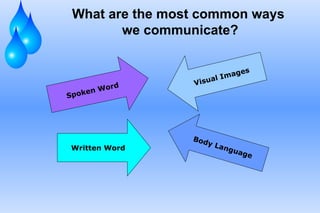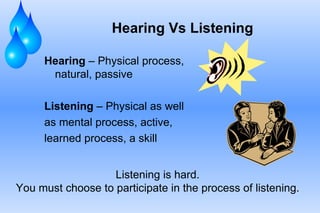Communication skills
- 1. COMMUNICATION SKILLS DAVID M.Phil, DEPT. OF BOTANY, ST. JOSEPH’S COLLEGE.
- 2. What is Communication? COMMUNICATION IS THE ART OF TRANSMITTING INFORMATION, IDEAS AND ATTITUDES FROM ONE PERSON TO ANOTHER.COMMUNICATION IS THE PROCESS OF MEANINGFUL INTERACTION AMONG HUMAN BEINGS.
- 3. ITS ESSENCES : PERSONAL PROCESS OCCURS BETWEEN PEOPLE INVOLVES CHANGE IN BEHAVIOUR MEANS TO INFLUENCE OTHERS EXPRESSION OF THOUGHTS AND EMOTIONS THROUGH WORDS & ACTIONS. TOOLS FOR CONTROLLING AND MOTIVATING PEOPLE. IT IS A SOCIAL AND EMOTIONAL PROCESS.
- 4. What are the most common ways we communicate? Spoken Word Written Word Visual Images Body Language
- 6. Source : Why to communicate? What to communicate? Usefulness of the communication. Accuracy of the Information to be communicated. Encoding : The process of transferring the information you want to communicate into a form that can be sent and correctly decoded at the other end. Ability to convey the information. Eliminate sources of confusion. For e.g. cultural issues, mistaken assumptions, and missing information. Knowing your audience.
- 7. Verbal Communication Channels Face-To-Face meetings, Telephones, Video Conferencing. Written Communication Channels Letters, e-Mails, Memos, Report
- 8. EFFECTIVE DECODING : Listen actively, Reading information carefully, Avoid Confusion, Ask question for better understanding. THE INFLUENCE FOR RECEIVER : The prior knowledge can influence the receiver’s understanding of the message. Blockages in the receiver’s mind. The surrounding disturbances
- 9. FEEDBACK: Feedback can be: Verbal Reactions and Non-Verbal Reactions. Positive feedback and Negative feedback.
- 10. CONTEXT: Various Cultures (Corporate, International, Regional, etc), Language, Location or Place (Restaurant, Office, Auditorium, Room, etc). Situation The sender needs to communicate the context to the receiver for better clarity in the communication process.
- 11. Barriers to communication Noise Inappropriate medium Assumptions/Misconceptions Emotions Language differences Poor listening skills Distractions
- 12. Hearing Vs Listening Hearing – Physical process, natural, passive Listening – Physical as well as mental process, active, learned process, a skill Listening is hard. You must choose to participate in the process of listening.
- 13. VALUE OF LISTENING Listening to others is an elegant art. Good listening reflects courtesy and good manners. Listening carefully to the instructions of superiors improve competence and performance. The result of poor listening skill could be disastrous in business, employment and social relations. Good listening can eliminate a number of imaginary grievances of employees. Good listening skill can improve social relations and conversation. Listening is a positive activity rather than a passive or negative activity.
- 14. Always think ahead about what you are going to say. Use simple words and phrases that are understood by every body. Increase your knowledge on all subjects you are required to speak. Speak clearly and audibly. Check twice with the listener whether you have been understood accurately or not In case of an interruption, always do a little recap of what has been already said. Always pay undivided attention to the speaker while listening. While listening, always make notes of important points. Always ask for clarification if you have failed to grasp other’s point of view. Repeat what the speaker has said to check whether you have understood accurately. ESSENTIALS OF COMMUNICATION Dos
- 15. ESSENTIALS OF COMMUNICATION DON’Ts Do not instantly react and mutter something in anger. Do not use technical terms & terminologies not understood by majority of people. Do not speak too fast or too slow. Do not speak in inaudible surroundings, as you won’t be heard. Do not assume that every body understands you. While listening do not glance here and there as it might distract the speaker. Do not interrupt the speaker. Do not jump to the conclusion that you have understood every thing.
- 16. How to Improve Existing Level of COMMUNICATION? IMPROVE LANGUAGE. IMPROVE PRONUNCIATIOON. WORK ON VOICE MODULATION. WORK ON BODY LANGUAGE. READ MORE LISTEN MORE AVOID READING OR WATCHING OR LISTENING UNWANTED LITERATURE, GOSSIP, MEDIA PRESENTATION ETC. INTERACT WITH QUALITATIVE PEOPLE. IMPROVE ON YOU TOPIC OF DISCUSSION, PRACTICE MEDITATION & GOOD THOUGHTS. THINK AND SPEAK. DO NOT SPEAK TOO FAST. USE SIMPLE VOCABULARY .
- 17. Improving Body Language - Tips Keep appropriate distance Touch only when appropriate Take care of your appearance Be aware - people may give false cues Maintain eye contact Smile genuinely
- 18. Some major areas of nonverbal behaviors to explore are: Eye contact Facial expressions Gestures Posture and body orientation
- 19. EYE CONTACT: Eye is an direct and most expressive part of our body. Different ways of Eye Contact Direct Eye Contact: (Shows confidence) Looking downwards (Listening carefully or Guilty) Single raised eyebrow (Doubting) Both raised eyebrows (Admiring) Bent eyebrows (Sudden focus) Tears coming out (Emotional either happy or hurt)
- 20. FACIAL EXPRESSION: Smile covers the most part of facial expression: Smiling is a powerful cue that transmits: Happiness Friendliness Warmth Liking Affiliation
- 21. GESTURES : If you fail to gesture while speaking, you may be perceived as boring, stiff and unanimated. A lively and animated teaching style captures students' attention, makes the material more interesting, facilitates learning and provides a bit of entertainment. Head nods, a form of gestures, communicate positive reinforcement to students and indicate that you are listening.
- 22. POSTURE AND BODY ORIENTATION You communicate numerous messages by the way you walk, talk, stand and sit. Standing erect, but not rigid, and leaning slightly forward communicates to students that you are approachable, receptive and friendly. Furthermore, interpersonal closeness results when you and your students face each other. Speaking with your back turned or looking at the floor or ceiling should be avoided; it communicates disinterest to your class.
- 23. EFFECTIVE PRESENTATION SKILLS Presentation Skills while appearing for an interview. Your Dressing sense (Males & Females), Documents needed to be carried, Your body language (while standing, while sitting, while walking), Your attitude (Soberness, Soft words, avoid western accent), Your Confidence (while talking, body movements, aggression, etc).
- 24. … in the new global and diverse workplace requires excellent communication skills! Success for YOU…
Editor's Notes
- 1























